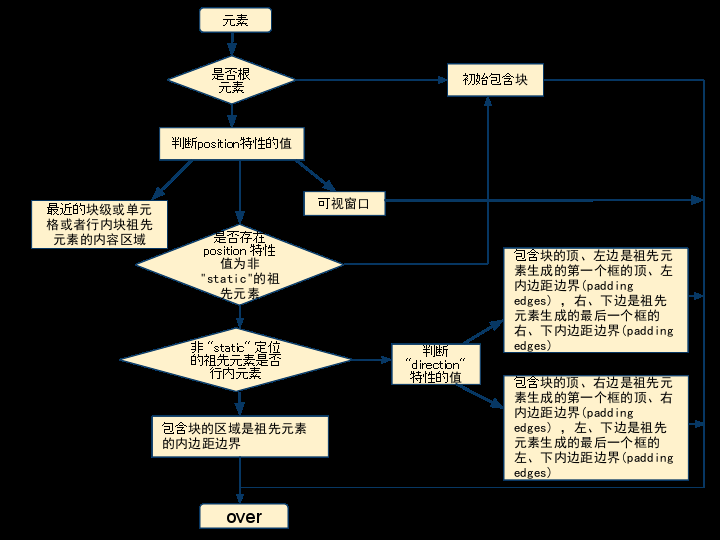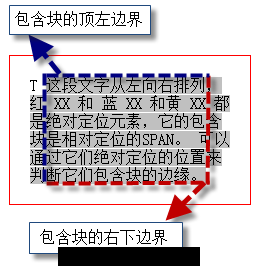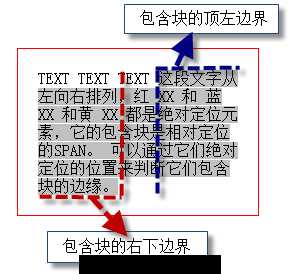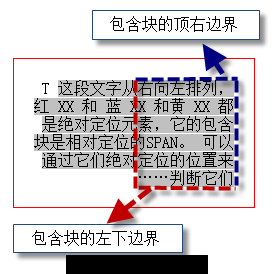“包含块(containing block)”,W3c中一个很重要的概念,今天带大家一起来好好研究下。
初步理解
在 CSS2.1 中,很多框的定位和尺寸的计算,都取决于一个矩形的边界,这个矩形,被称作是包含块( containing block )。 一般来说,(元素)生成的框会扮演它子孙元素包含块的角色,我们称之为:一个(元素的)框为它的子孙节点建造了包含块。包含块是一个相对的概念。
<div>
<table>
<tr>
<td>hi</td>
</tr>
</table>
</div>
以上代码为例,DIV 和 TABLE 都是包含块。DIV 是 TABLE 的包含块,同时 TABLE 又是 TD 的包含块,不是绝对的。
“一个框的包含块”,指的是“该框所存在的那个包含块”,并不是它建造的包含块。比如,上述代码中,TABLE 的包含块,说的是 DIV 建造的包含块,而不是 TABLE 自身建造的包含块。TABLE 建造的包含块,可以称作 TD 的包含块。
每个框关于它的包含块都有一个位置,但是它不会被包含块限制;它可以溢出(包含块)。包含块上可以通过设置 ‘overflow’ 特性达到处理溢出的子孙元素的目的。
包含块的概念很重要,因为可视化格式模型中很多的理论性知识都跟这个概念有关系,比如,宽度高度自动值的计算,浮动元素的定位,绝对定位元素的定位等等。不了解包含块,就掌握不好以它为基础的后续理论。
官方定义
The position and size of an element’s box(es) are sometimes calculated relative to a certain rectangle, called the containing block of the element.
一个元素的盒模型的定位、尺寸常常会依据某个矩形(box)来计算,这个矩形就叫做这个元素的包含块(containing block)。
判定规则
- The containing block in which the root
element lives is a rectangle called the initial containing block. For continuous
media, it has the dimensions of the viewport and is anchored at the
canvas origin; it is the page area
for paged media. The ‘direction’ property of the initial
containing block is the same as for the root element.
页面中的根元素所存在的包含块,被称为初始包含块(initial containing block) - For other elements, if the element’s position is ‘relative’ or ‘static’,
the containing block is formed by the content edge of the nearest
block container ancestor box.
如果一个元素的’position’为’relative’或’static’,那么其包含块则是由最近的块级或单元格或行内块级元素的内容区创建 - If the element has ‘position: fixed’, the containing block is
established by the viewport
in the case of continuous media or the page area in the case of paged media.
如果一个元素’position’为’fixed’,那么其包含块为当前屏幕的可视窗口 - If the element has ‘position: absolute’, the containing block is
established by the nearest ancestor with a ‘position‘ of ‘absolute’, ‘relative’
or ‘fixed’, in the following way
如果一个元素的’position’为’absolute’,那么其包含块则是最近的’position’为’relative’ 或’absolute’或 ‘fixed’的祖先元素,有如下几种情况:- In the case that the ancestor is an inline element, the containing
block is the bounding box around the padding boxes of the first and
the last inline boxes
generated for that element. In CSS 2.1, if the inline
element is split
across multiple lines, the containing block is undefined.
如果其祖先元素是行内元素,则包含块取决于其祖先元素的 “direction” 特性 - Otherwise, the containing block
is formed by the padding edge of the ancestor.
其他情况下,如果祖先元素不是行内元素,那么包含块的区域应该是祖先元素的内边距边界。
- In the case that the ancestor is an inline element, the containing
根据W3C的规定,我们可以用一张图来表达这个判定:

重点讲解
静态定位元素和相对定位元素
如果该元素的定位(position)为 “relative” (相对定位)或者 “static”(静态定位),它的包含块由它最近的块级、单元格(table cell)或者行内块(inline-block)祖先元素的 内容框创建。元素如果未声明 ‘position’ 特性,那么就会采用 ‘position’ 的默认值 “static”。
<table id="table1">
<tr>
<td id="td1">
<div id="div1" style="padding:20px;border:1px solid red;">
<span> <strong id=”greed” style="position:relative;">greed is</strong> fsdfd</span>
</div>
</td>
</tr>
</table>
包含块关系表:
| 元素 | 包含块 |
|---|---|
| table1 | body |
| td1 | table1 |
| div1 | td1 |
| greed | div1 |
SPAN 元素中包含的文本在 div1 中的位置可以看出,div1 创建的包含块的区域是它的内容边界,也就是内边界。
固定定位元素
如果元素是固定定位 (“position:fixed”) 元素,那么它的包含块是当前可视窗口。
绝对定位元素
总的来说,绝对定位(”position: absolute”)元素的包含块由离它最近的 ‘position’ 属性为 ‘absolute’、’relative’ 或者 ‘fixed’ 的祖先元素创建。
如果其祖先元素是行内元素,则包含块取决于其祖先元素的 ‘direction’ 特性
1). 如果 ‘direction’ 是 ‘ltr’,包含块的顶、左边是祖先元素生成的第一个框的顶、左内边距边界(padding edges) ,右、下边是祖先元素生成的最后一个框的右、下内边距边界(padding edges)
示例代码:
<p style="border:1px solid red; width:200px; padding:20px;"> T <span style="background-color:#C0C0C0; position:relative;"> 这段文字从左向右排列,红 XX 和 蓝 XX 和黄 XX 都是绝对定位元素,它的包含块是相对定位的SPAN。 可以通过它们绝对定位的位置来判断它们包含块的边缘。 <em style="position:absolute; color:red; top:0; left:0;">XX</em> <em style="position:absolute; color:yellow; top:20px; left:0;">XX</em> <em style="position:absolute; color:blue; bottom:0; right:0;">XX</em> </span> </p>
以上代码中,文字采取默认从左到右的方式排列。红 XX 和 蓝 XX 和黄 XX 都是绝对定位元素,它的包含块是相对定位的 SPAN。 它们定位需要参照包含块,按照标准来说,它们包含块的左顶边是 SPAN 形成的第一个框(即第一行的灰色部分)的顶、左内边距边,包含块的右、下边是 SPAN 生成的最后一个框(最后一行灰色的部分)的右、下内边距边界。
示意图:

行内元素内形成的包含块,在各浏览器中各不相同,存在兼容性问题。可以通过上面的例子可以证明这一点。蓝色的 “XX” 的位置在各浏览器中都不一样。(经测试,IE、opera、webkit内核浏览器都正常,火狐不正常)
包含块的宽度可能是负的。
示例代码:
<p style="border:1px solid red; width:200px; padding:20px;"> TEXT TEXT TEXT <span style="background-color:#C0C0C0; position:relative;"> 这段文字从左向右排列,红 XX 和 蓝 XX 和黄 XX 都是绝对定位元素,它的包含块是相对定位的SPAN。 可以通过它们绝对定位的位置来判断它们包含块的边缘。 <em style="position:absolute; color:red; top:0; left:0;">XX</em> <em style="position:absolute; color:yellow; top:20px; left:0;">XX</em> <em style="position:absolute; color:blue; bottom:0; right:0;">XX</em> </span> </p>
示意图:

以上的边界无法围成一个区域,在这种情况下,包含块的宽度是负的。
2). 如果 ‘direction’ 是 ‘rtl’,包含块的顶、右边是祖先元素生成的第一个框的顶、右内边距边界 (padding edges) ,左、下边是祖先元素生成的最后一个框的左、下内边距边界 (padding edges)
示例代码:
<p style="border:1px solid red; width:200px; padding:20px; direction:rtl;"> T <span style="background-color:#C0C0C0; position:relative;"> 这段文字从右向左排列,红 XX 和 蓝 XX 和黄 XX 都是绝对定位元素,它的包含块是相对定位的SPAN。 可以通过它们绝对定位的位置来判断它们…… <em style="position:absolute; color:red; top:0; left:0;">XX</em> <em style="position:absolute; color:yellow; top:20px; left:0;">XX</em> <em style="position:absolute; color:blue; bottom:0; right:0;">XX</em> </span> </p>
示意图:

其他情况下,如果祖先元素不是行内元素,那么包含块的区域应该是祖先元素的内边距边界
示例代码:
<div id="container" style="padding:50px; background-color:#c0c0c0; position:relative; width:200px; height:200px;"> <div id="div1" style="width:100%; height:100%; border:2px solid blue;"> <div id="content" style="border:1px solid red; position:absolute; left:0; top:0;">absolute element</div> </div> </div>
以上代码中,content 的父元素虽是 div1,但,按照标准它的包含块应该是 container。
注意事项
- 在 (X)HTML 中,根元素是 html 元 素(尽管有的浏览器会不正确地使用 body 元素)
- 内容区指的是元素的内容,如文本,图形等,不包括paddingordermargin等
- 如果absolute的元素的非”static”的祖先元素是inline元素,需要判定direction的值来做出包含块的判定(但目前正常 的文档流方向都是ltr,除非你去刻意修改,在这种情况下包含块的topleftottom ight与最近的非static的tlbr边界是一 致的)
- 如果一个元素为fixed,这时它的包含块是可视窗口,这里的可视窗口是指浏览器正常的window视窗,当然这个视窗可以人为的缩放
参考资源:
http://w3help.org/zh-cn/kb/007/